Group Connection Testing
Group Connection Testing#
In this notebook we will be testing whether the hemispheres/segments come from an stochastic block model, which models graphs containing communities, in which subsets of nodes within each community are characterized as being connected to each other with particular edge densities. Here, our communities are determined by the classes of the neurons within each hemisphere/segment, which we are considering can be interneuron, motorneuron, or sensory neuron.
import logging
import pandas as pd
import numpy as np
import csv
import networkx as nx
import itertools
import seaborn as sns
from pathlib import Path
from networkx import from_pandas_adjacency
from itertools import chain, combinations
from matplotlib import pyplot as plt
from collections import namedtuple
from graspologic.inference import group_connection_test
from graspologic.plot import heatmap, adjplot
from pkg.platy import _get_folder, load_connectome_normal_lcc_annotations, load_left_adj_labels, load_right_adj_labels, load_head_adj_labels, load_pygidium_adj_labels, load_0_adj_labels, load_1_adj_labels, load_2_adj_labels, load_3_adj_labels
folder = _get_folder()
annotations = load_connectome_normal_lcc_annotations()
folder
PosixPath('/Users/kareefullah/Desktop/NeuroData/neurodata/platy-data/docs/outputs')
The following blocks of code generate dataframes, where the skids_df represent the skids of interest in the hemispheres/segments and labels_df represent the corresponding labels of the classes of the neurons
left_adj, _ = load_left_adj_labels()
left_adj_index = list(left_adj.index)
right_adj, _ = load_right_adj_labels()
right_adj_index = list(right_adj.index)
all_hemi_index = left_adj_index + right_adj_index
all_hemi_index = [int(i) for i in all_hemi_index]
skids_hemis = {"l": [], "r": []}
labels_hemis = {"l": [], "r": []}
poss_labels = ["s", "i", "m"]
#add skids and labels for hemis;
for key in skids_hemis:
for i in range(len(annotations["skids"])):
#check if the skid is in the left/right adj (normal, lcc), and the side is left or right, and the class exists as sensory, motor, or inter
if(annotations["skids"][i] in all_hemi_index and annotations["side"][i]==key and annotations["class"][i] in poss_labels):
skids_hemis[key].append(annotations["skids"][i])
labels_hemis[key].append(annotations["class"][i])
#convert dicts to dataframes
skids_hemis_df = pd.DataFrame(dict([(k, pd.Series(v)) for k,v in skids_hemis.items()]))
labels_hemis_df = pd.DataFrame(dict([(k, pd.Series(v)) for k,v in labels_hemis.items()]))
skids_hemis_df.to_csv(folder / "skids_hemis_classes.csv")
labels_hemis_df.to_csv(folder / "labels_hemis_classes.csv")
head_adj, _ = load_head_adj_labels()
head_adj_index = list(head_adj.index)
pyg_adj, _ = load_pygidium_adj_labels()
pyg_adj_index = list(pyg_adj.index)
#adj_0, _ = load_0_adj_labels()
#adj_0_index = list(adj_0.index)
adj_1, _ = load_1_adj_labels()
adj_1_index = list(adj_1.index)
adj_2, _ = load_2_adj_labels()
adj_2_index = list(adj_2.index)
adj_3, _ = load_3_adj_labels()
adj_3_index = list(adj_3.index)
all_segs_index = head_adj_index + pyg_adj_index + adj_1_index + adj_2_index + adj_3_index
all_segs_index = [int(i) for i in all_segs_index]
skids_segs = {"head": [], "pygidium": [], "1": [], "2": [], "3": []}
labels_segs = {"head": [], "pygidium": [], "1": [], "2": [], "3": []}
for key in skids_segs:
for i in range(len(annotations["skids"])):
if(annotations["skids"][i] in all_segs_index and annotations["segment"][i]==key and annotations["class"][i] in poss_labels):
skids_segs[key].append(annotations["skids"][i])
labels_segs[key].append(annotations["class"][i])
skids_segs_df = pd.DataFrame(dict([(k, pd.Series(v)) for k,v in skids_segs.items()]))
labels_segs_df = pd.DataFrame(dict([(k, pd.Series(v)) for k,v in labels_segs.items()]))
skids_segs_df.to_csv(folder / "skids_segs_classes.csv")
labels_segs_df.to_csv(folder / "labels_segs_classes.csv")
We make barplots for the counts of each of the classes across the hemispheres/segments using the dictionaries we generated above
new_folder = Path.joinpath(folder, "group_connection_plots")
new_folder
PosixPath('/Users/kareefullah/Desktop/NeuroData/neurodata/platy-data/docs/outputs/group_connection_plots')
#comparison for hemis
count_hemis = {"l" : {"s": 0, "i": 0, "m": 0}, "r": {"s": 0, "i": 0, "m": 0}}
for key in count_hemis:
for i in range(len(labels_hemis[key])):
count_hemis[key][labels_hemis[key][i]] += 1
# get the lists of number of skids for y values, x values are the keys
keys = poss_labels # "s", "i", "m"
list_counts_hemis = []
class_label_hemis = []
hemi_label = []
# loop through "l" and "r"
for key in count_hemis:
# loop through "s", "i", "m"
for inner_key in count_hemis[key]:
# append "s" "i" or "m"
class_label_hemis.append(inner_key)
# add 1 to the count of the respective class label in the respective key of count_hemis
list_counts_hemis.append(count_hemis[key][inner_key])
# append the outer key from count_hemis
hemi_label.append(key)
label_counts = list(zip(class_label_hemis, list_counts_hemis, hemi_label))
df_hemis = pd.DataFrame(label_counts, columns = ["class", "count", "side"])
df_hemis.to_csv(new_folder / "hemi_classes_counts.csv")
df_hemis
| class | count | side | |
|---|---|---|---|
| 0 | s | 236 | l |
| 1 | i | 362 | l |
| 2 | m | 91 | l |
| 3 | s | 229 | r |
| 4 | i | 367 | r |
| 5 | m | 96 | r |
sns.set(style="white")
sns.barplot(x="class", y="count", hue="side", data=df_hemis)
plt.title("counts of classes across hemis")
plt.savefig(new_folder / "hemi_classes_barplot.png")

#comparison for segments
count_segs = {"head" : {"s": 0, "i": 0, "m": 0},
"pygidium": {"s": 0, "i": 0, "m": 0},
"1" : {"s": 0, "i": 0, "m": 0},
"2" : {"s": 0, "i": 0, "m": 0},
"3" : {"s": 0, "i": 0, "m": 0},}
for key in count_segs:
for i in range(len(labels_segs[key])):
count_segs[key][labels_segs[key][i]] += 1
print(count_segs)
# get the lists of number of skids for y values, x values are the keys
keys = poss_labels # "s", "i", "m"
list_counts_segs = []
class_label_segs = []
segs_label = []
# loop through "l" and "r"
for key in count_segs:
# loop through "s", "i", "m"
for inner_key in count_segs[key]:
# append "s" "i" or "m"
class_label_segs.append(inner_key)
# add 1 to the count of the respective class label in the respective key of count_hemis
list_counts_segs.append(count_segs[key][inner_key])
# append the outer key from count_hemis
segs_label.append(key)
label_counts_segs = list(zip(class_label_segs, list_counts_segs, segs_label))
df_segs = pd.DataFrame(label_counts_segs, columns = ["class", "count", "segment"])
df_segs.to_csv(new_folder / "segs_classes_counts.csv")
df_segs
{'head': {'s': 310, 'i': 339, 'm': 22}, 'pygidium': {'s': 40, 'i': 13, 'm': 3}, '1': {'s': 21, 'i': 113, 'm': 45}, '2': {'s': 40, 'i': 150, 'm': 67}, '3': {'s': 40, 'i': 98, 'm': 49}}
| class | count | segment | |
|---|---|---|---|
| 0 | s | 310 | head |
| 1 | i | 339 | head |
| 2 | m | 22 | head |
| 3 | s | 40 | pygidium |
| 4 | i | 13 | pygidium |
| 5 | m | 3 | pygidium |
| 6 | s | 21 | 1 |
| 7 | i | 113 | 1 |
| 8 | m | 45 | 1 |
| 9 | s | 40 | 2 |
| 10 | i | 150 | 2 |
| 11 | m | 67 | 2 |
| 12 | s | 40 | 3 |
| 13 | i | 98 | 3 |
| 14 | m | 49 | 3 |
sns.set(style="white")
sns.barplot(x="class", y="count", hue="segment", data=df_segs)
plt.title("counts of classes across segments")
plt.savefig(new_folder / "segs_classes_barplot.png")

We will now visualize the adjs of the hemispheres/segments, in which the nodes will be grouped into communities of sensory, motor, or interneurons
from pkg.platy import load_0_adj_labels, load_1_adj_labels, load_2_adj_labels, load_3_adj_labels, load_right_adj_labels, load_left_adj_labels, load_head_adj_labels, load_pygidium_adj_labels
#block for loading adjs/labels
#hemis
left_adj, left_labels = load_left_adj_labels()
right_adj, right_labels = load_right_adj_labels()
#segments
head_adj, head_labels = load_head_adj_labels()
pyg_adj, pyg_labels = load_pygidium_adj_labels()
#adj_0, labels_0 = load_0_adj_labels()
adj_1, labels_1 = load_1_adj_labels()
adj_2, labels_2 = load_2_adj_labels()
adj_3, labels_3 = load_3_adj_labels()
#lists for adjs/labels/names
hemi_adjs = [left_adj, right_adj]
for i, val in enumerate(hemi_adjs):
hemi_adjs[i] = val.to_numpy()
segment_adjs = [head_adj, pyg_adj, adj_1, adj_2, adj_3]
for i, val in enumerate(segment_adjs):
segment_adjs[i] = val.to_numpy()
all_adjs = hemi_adjs + segment_adjs
hemi_labels = [left_labels, right_labels]
segment_labels = [head_labels, pyg_labels, labels_1, labels_2, labels_3]
all_labels = hemi_labels + segment_labels
hemi_names = ["left", "right"]
segment_names = ["head", "pygidium", "1", "2", "3"]
all_names = hemi_names + segment_names
#scatterplots
#metadata
metas = []
for i in range(len(all_adjs)):
metas.append(pd.DataFrame(
data={
"{}_labels".format(all_names[i]): all_labels[i]
},
))
for i in range(len(all_adjs)):
adjplot(all_adjs[i], plot_type="scattermap", meta=metas[i], group=["{}_labels".format(all_names[i])])
plt.savefig(new_folder / "scatterplots" / "connection_{}".format(all_names[i]))
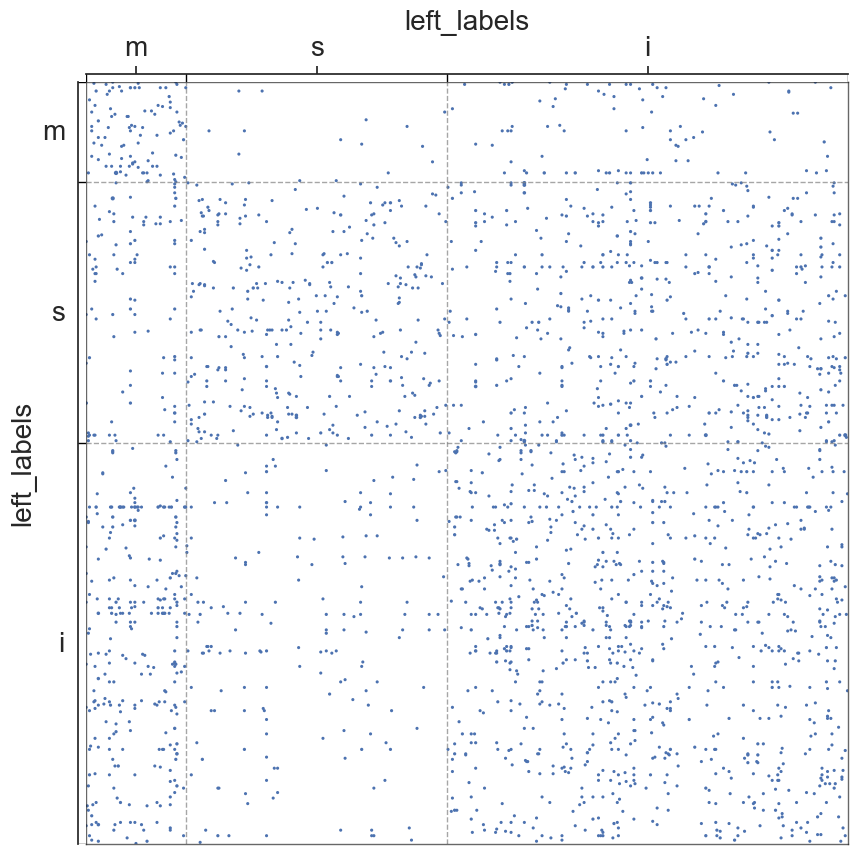
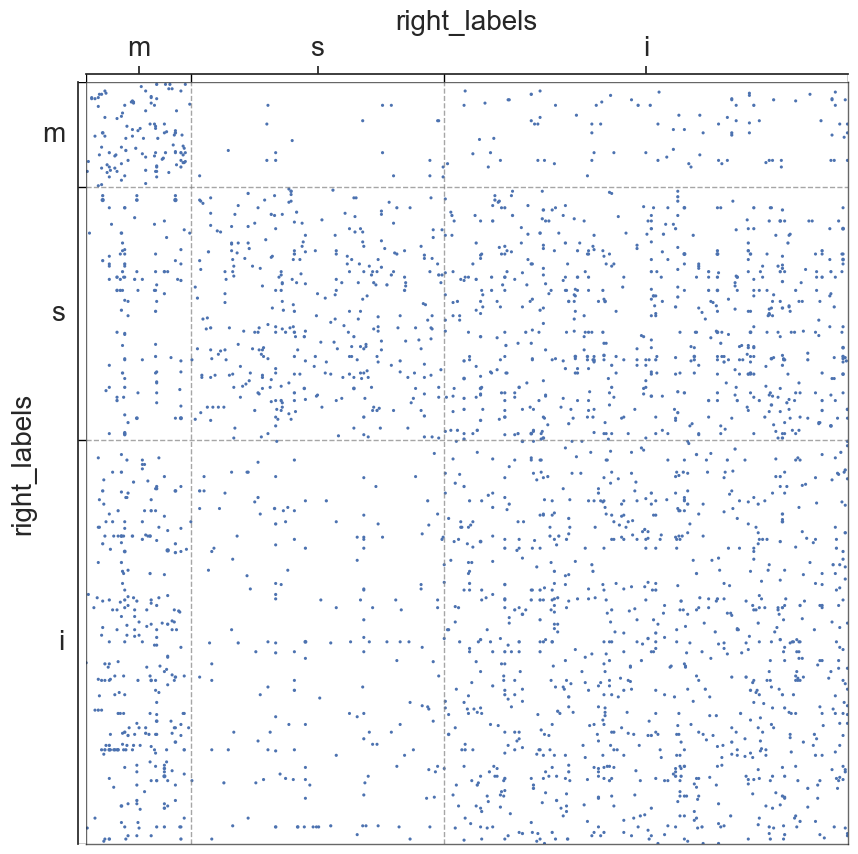
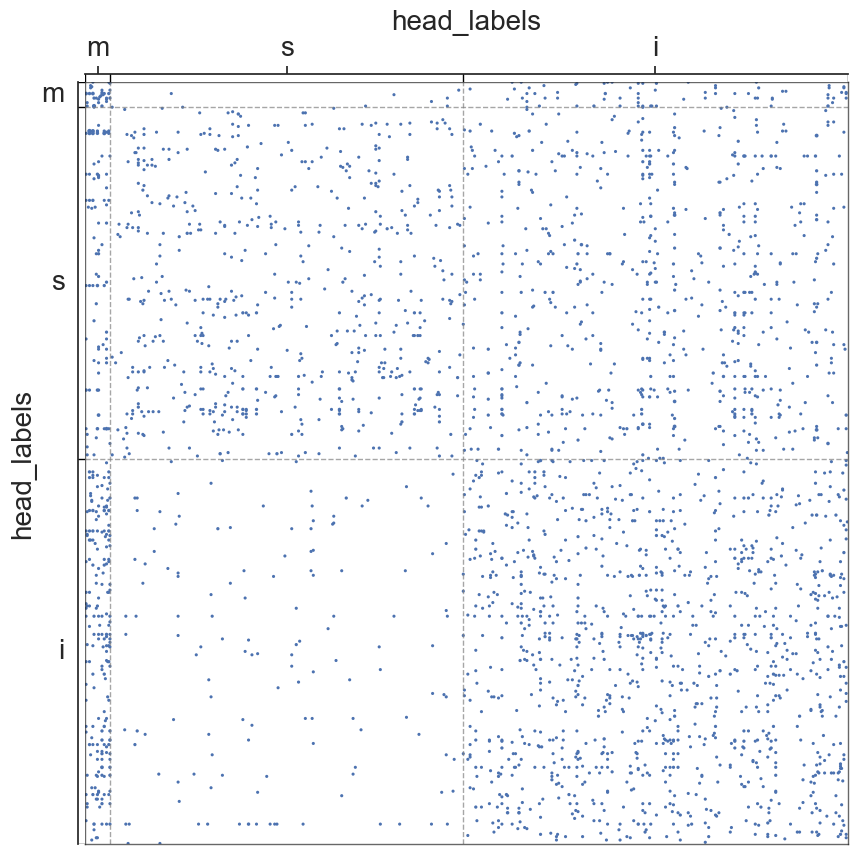
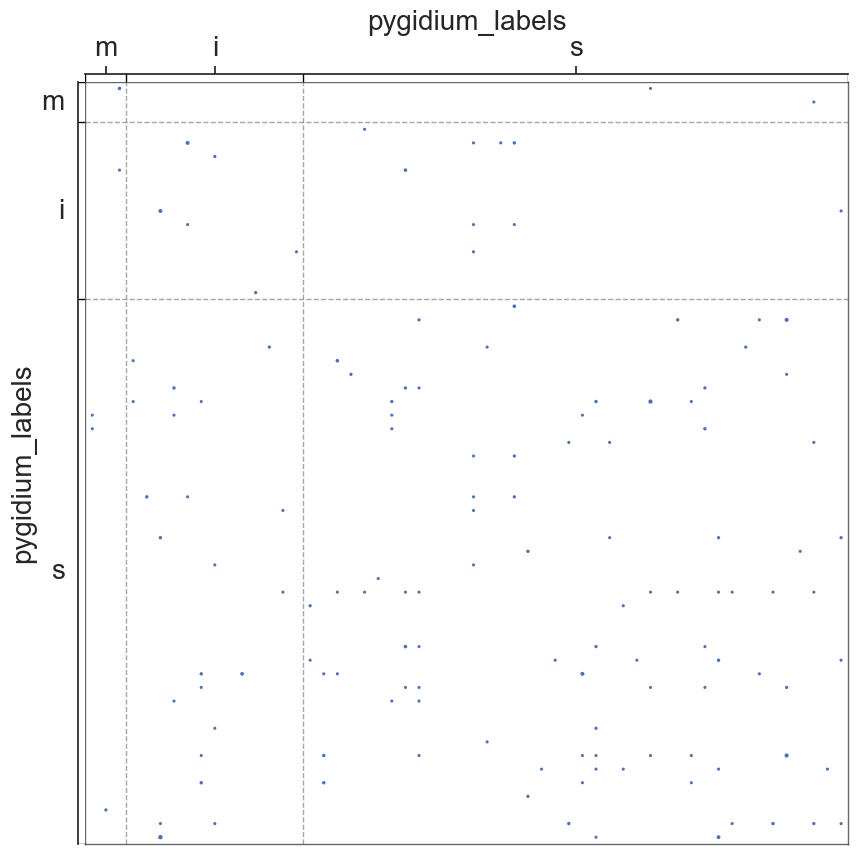
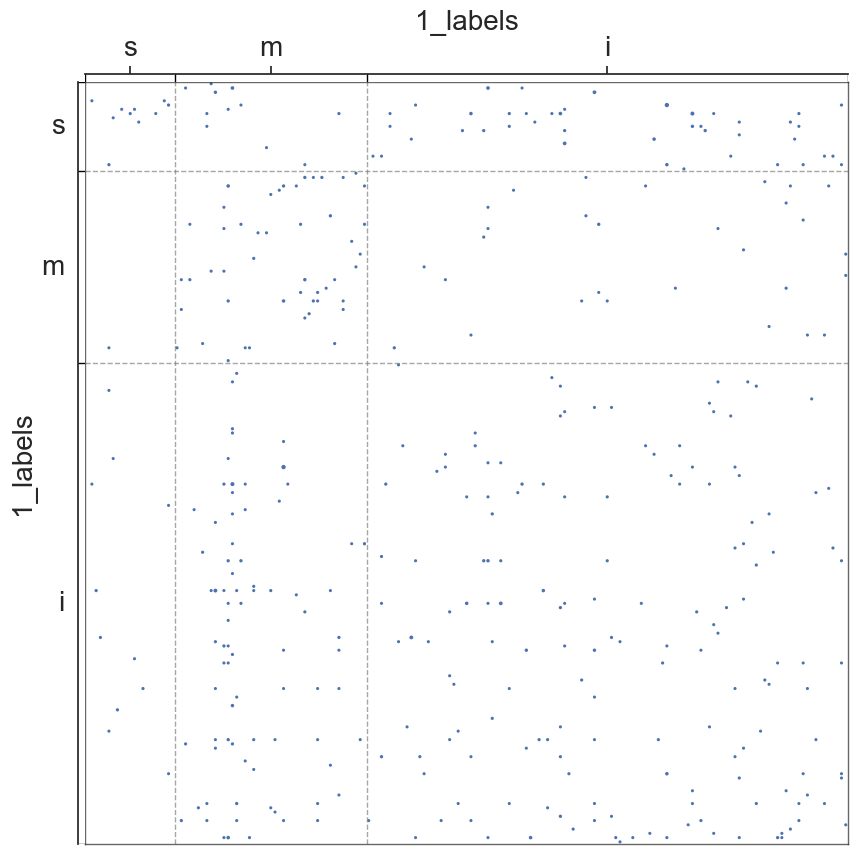
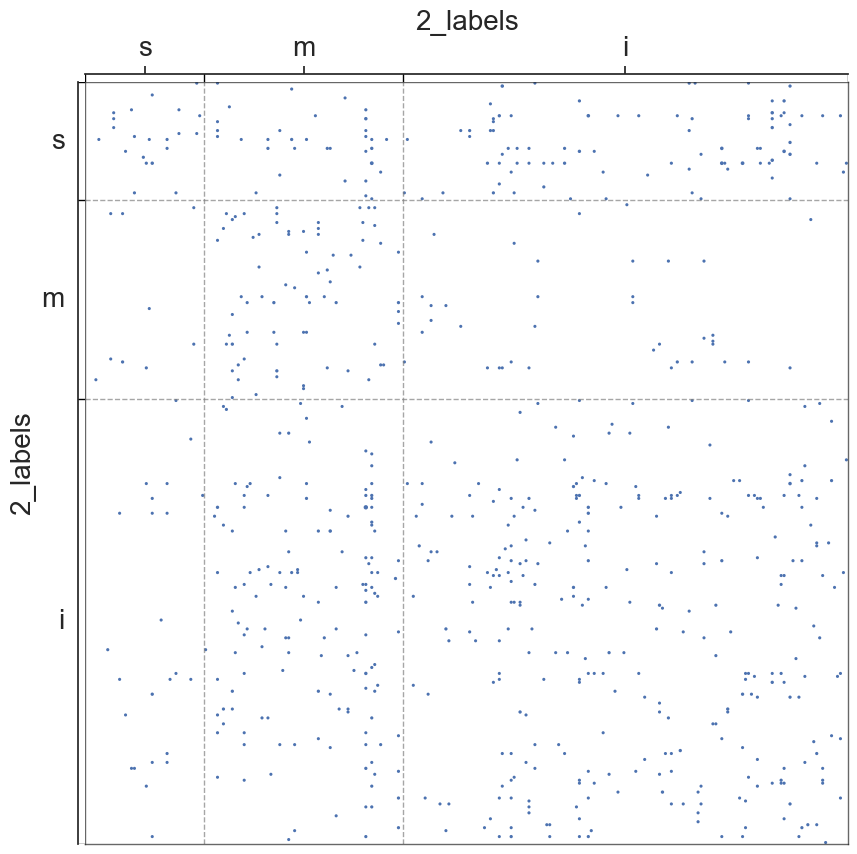

Group Connection Test for Left and Right Hemispheres
stat, pval, misc = group_connection_test(hemi_adjs[0], hemi_adjs[1], hemi_labels[0], hemi_labels[1])
pval
0.0696626995269396
We do the same for all the pairwise combinations of segments
pairwise_labels = list(itertools.combinations(segment_labels, 2))
pairwise_adjs = list(itertools.combinations(segment_adjs, 2))
pairwise_names = list(itertools.combinations(segment_names, 2))
#initialize dataframe
zero_data = np.zeros(shape=(len(segment_names), len(segment_names)))
pval_df = pd.DataFrame(zero_data, columns=segment_names, index=segment_names)
pval_list = []
for label, adjs, name in zip(pairwise_labels, pairwise_adjs, pairwise_names):
stat, pval, misc = group_connection_test(adjs[0], adjs[1], label[0], label[1])
#lower limit
thres = 1e-12
if pval<thres:
pval = thres
pval_df[name[0]][name[1]] = pval
pval_df[name[1]][name[0]] = pval
pval_df.to_csv(folder / "group_connection_plots" / "group_connection_test_pvals_segments.csv")
pval_df
| head | pygidium | 1 | 2 | 3 | |
|---|---|---|---|---|---|
| head | 0.000000e+00 | 1.000000e-12 | 2.702963e-08 | 4.181329e-10 | 1.000000e-12 |
| pygidium | 1.000000e-12 | 0.000000e+00 | 1.332503e-02 | 1.804581e-11 | 9.981189e-03 |
| 1 | 2.702963e-08 | 1.332503e-02 | 0.000000e+00 | 2.230677e-01 | 8.466542e-01 |
| 2 | 4.181329e-10 | 1.804581e-11 | 2.230677e-01 | 0.000000e+00 | 1.325808e-03 |
| 3 | 1.000000e-12 | 9.981189e-03 | 8.466542e-01 | 1.325808e-03 | 0.000000e+00 |
Let’s use bonferroni’s correction on the segment p-values to reduce the chances of obtaining false positive results since we are using multiple pairwise tests
#bonferroni correction for non-density adjusted p-vals
from statsmodels.stats.multitest import multipletests
np_pvals = pval_df.to_numpy().flatten()
corrected_pvals = multipletests(np_pvals)[1].reshape((len(segment_names), len(segment_names)))
pvals_df_bonferroni_corrected = pd.DataFrame(corrected_pvals, columns=segment_names, index=segment_names)
pvals_df_bonferroni_corrected
| head | pygidium | 1 | 2 | 3 | |
|---|---|---|---|---|---|
| head | 0.000000e+00 | 2.000000e-11 | 3.243555e-07 | 5.853861e-09 | 2.000000e-11 |
| pygidium | 2.000000e-11 | 0.000000e+00 | 7.733367e-02 | 2.887330e-10 | 7.711503e-02 |
| 1 | 3.243555e-07 | 7.733367e-02 | 0.000000e+00 | 6.356383e-01 | 9.764851e-01 |
| 2 | 5.853861e-09 | 2.887330e-10 | 6.356383e-01 | 0.000000e+00 | 1.317926e-02 |
| 3 | 2.000000e-11 | 7.711503e-02 | 9.764851e-01 | 1.317926e-02 | 0.000000e+00 |
Now, let’s use the density adjusted version of group connection tests, which accounts for the potential difference in density across the adjs (are the group-to-group connection probabilities of one adj simply a scaled-up version of those of the other)
stat, pval, misc = group_connection_test(hemi_adjs[0], hemi_adjs[1], hemi_labels[0], hemi_labels[1], density_adjustment=True)
pval
0.2215230390623611
pairwise_labels = list(itertools.combinations(segment_labels, 2))
pairwise_adjs = list(itertools.combinations(segment_adjs, 2))
pairwise_names = list(itertools.combinations(segment_names, 2))
#initialize dataframe
zero_data = np.zeros(shape=(len(segment_names), len(segment_names)))
pval_df_density_correct = pd.DataFrame(zero_data, columns=segment_names, index=segment_names)
pval_list = []
for label, adjs, name in zip(pairwise_labels, pairwise_adjs, pairwise_names):
stat, pval, misc = group_connection_test(adjs[0], adjs[1], label[0], label[1], density_adjustment=True)
#lower limit
if pval<thres:
pval = thres
pval_df_density_correct[name[0]][name[1]] = pval
pval_df_density_correct[name[1]][name[0]] = pval
pval_df_density_correct.to_csv(folder / "group_connection_plots" / "group_connection_test_pvals_segments_density_adjust.csv")
pval_df_density_correct
| head | pygidium | 1 | 2 | 3 | |
|---|---|---|---|---|---|
| head | 0.000000e+00 | 0.028693 | 1.000000e-12 | 3.137590e-11 | 4.537271e-11 |
| pygidium | 2.869298e-02 | 0.000000 | 8.940516e-01 | 9.617347e-01 | 9.434038e-01 |
| 1 | 1.000000e-12 | 0.894052 | 0.000000e+00 | 6.005472e-01 | 7.561597e-01 |
| 2 | 3.137590e-11 | 0.961735 | 6.005472e-01 | 0.000000e+00 | 1.257010e-02 |
| 3 | 4.537271e-11 | 0.943404 | 7.561597e-01 | 1.257010e-02 | 0.000000e+00 |
Using Bonferroni’s correction for the density adjusted segments:
np_pvals_density_correct = pval_df_density_correct.to_numpy().flatten()
corrected_pvals_density_correct = multipletests(np_pvals_density_correct)[1].reshape((len(segment_names), len(segment_names)))
pvals_df_density_corrected_bonferroni_corrected = pd.DataFrame(corrected_pvals_density_correct, columns=segment_names, index=segment_names)
pvals_df_density_corrected_bonferroni_corrected
| head | pygidium | 1 | 2 | 3 | |
|---|---|---|---|---|---|
| head | 0.000000e+00 | 0.294855 | 2.000000e-11 | 5.647662e-10 | 7.259633e-10 |
| pygidium | 2.948552e-01 | 0.000000 | 9.999986e-01 | 9.999986e-01 | 9.999986e-01 |
| 1 | 2.000000e-11 | 0.999999 | 0.000000e+00 | 9.998966e-01 | 9.999875e-01 |
| 2 | 5.647662e-10 | 0.999999 | 9.998966e-01 | 0.000000e+00 | 1.623013e-01 |
| 3 | 7.259633e-10 | 0.999999 | 9.999875e-01 | 1.623013e-01 | 0.000000e+00 |
The following functions will allow us to visualize the p-values of the segments in a heatmap, where significant p-values are denoted with an X
from matplotlib.transforms import Bbox
def shrink_axis(ax, scale=0.7, shift=0):
pos = ax.get_position()
mid = (pos.ymax + pos.ymin) / 2
height = pos.ymax - pos.ymin
new_pos = Bbox(
[
[pos.xmin, mid - scale * 0.5 * height - shift],
[pos.xmax, mid + scale * 0.5 * height - shift],
]
)
ax.set_position(new_pos)
import matplotlib as mpl
cmap = mpl.colormaps["RdBu"]
from seaborn.utils import relative_luminance
import matplotlib as mpl
def plot_pvals(df, names, density_correct=True, bonferroni_correct=False, ax=None, thres=None):
if ax is None:
width_ratios = [0.5, 3, 10]
fig, axs = plt.subplots(
1,
3,
figsize=(10, 10),
gridspec_kw=dict(
width_ratios=width_ratios,
),
)
axs[1].remove()
ax = axs[-1]
cax = axs[0]
plot_pvalues = np.log10(df)
plot_pvalues.replace(-np.inf, 0, inplace=True)
im = sns.heatmap(
plot_pvalues,
ax=ax,
cmap="RdBu",
center=0,
square=True,
cbar=False,
fmt="s",
)
title = "Group Connection p-values segments"
if density_correct == True:
title += " (density adjusted)"
if bonferroni_correct == True:
title += " (bonferroni corrected)"
ax.set(ylabel="Source group", xlabel="Target group", title=title)
ax.set(xticks=np.arange(len(names)) + 0.5, xticklabels=names)
colors = im.get_children()[0].get_facecolors()
print(im.get_children()[0])
#print(colors)
shrink_axis(cax, scale=0.5, shift=0.05)
fig = ax.get_figure()
if thres is None:
cb = fig.colorbar(
im.get_children()[0],
cax=cax,
fraction=1,
shrink=1,
ticklocation="left",
)
#do threshold stuff: set ticks based on thres and then follow tutorial to make everything outside the threshold a diff color; then set ticks=ticks
if thres is not None:
#account for change in threshold from bonferroni correction
# if bonferroni_correct == True:
# thres = 1e-5
cb = fig.colorbar(
im.get_children()[0],
cax=cax,
fraction=1,
shrink=1,
ticks=np.linspace(np.log(thres), 0, 10),
ticklocation="left",
)
"""cmap = mpl.colormaps["RdBu"]
norm = mpl.colors.BoundaryNorm(ticks, colors.N, extend="both")
cb = fig.colorbar(mpl.cm.ScalarMappable(norm=norm, cmap=colors), cax=cax, fraction=1, shrink=1, ticklocation="left")"""
cax.set_title(r"$log_{10}$" + "\ncorrected" "\np-value", pad=20)
cax.plot(
[0, 1], [np.log10(0.05), np.log10(0.05)], zorder=100, color="black", linewidth=3
)
cax.annotate(
r"$\alpha$",
(0.05, np.log10(0.05)),
xytext=(-5, 0),
textcoords="offset points",
va="center",
ha="right",
arrowprops={"arrowstyle": "-", "linewidth": 3, "relpos": (0, 0.5)},
)
#make X's
pad=0.2
for idx, color in enumerate(colors):
i, j = np.unravel_index(idx, (len(names), len(names)))
if i!=j and np.log(df[names[i]][names[j]]) < np.log(0.05):
lum = relative_luminance(color)
text_color = ".15" if lum > 0.408 else "w"
xs = [j + pad, j + 1 - pad]
ys = [i + pad, i + 1 - pad]
ax.plot(xs, ys, color=text_color, linewidth=4)
xs = [j + 1 - pad, j + pad]
ys = [i + pad, i + 1 - pad]
ax.plot(xs, ys, color=text_color, linewidth=4)
plot_pvals(df=pval_df, names=segment_names, density_correct=False, bonferroni_correct=False, thres=thres)
plt.savefig(new_folder / "group_connection_heatmap_segments")
/Users/kareefullah/Library/Caches/pypoetry/virtualenvs/platy-data-EVeqgmAk-py3.9/lib/python3.9/site-packages/pandas/core/internals/blocks.py:351: RuntimeWarning: divide by zero encountered in log10
result = func(self.values, **kwargs)
<matplotlib.collections.QuadMesh object at 0x1336b0640>
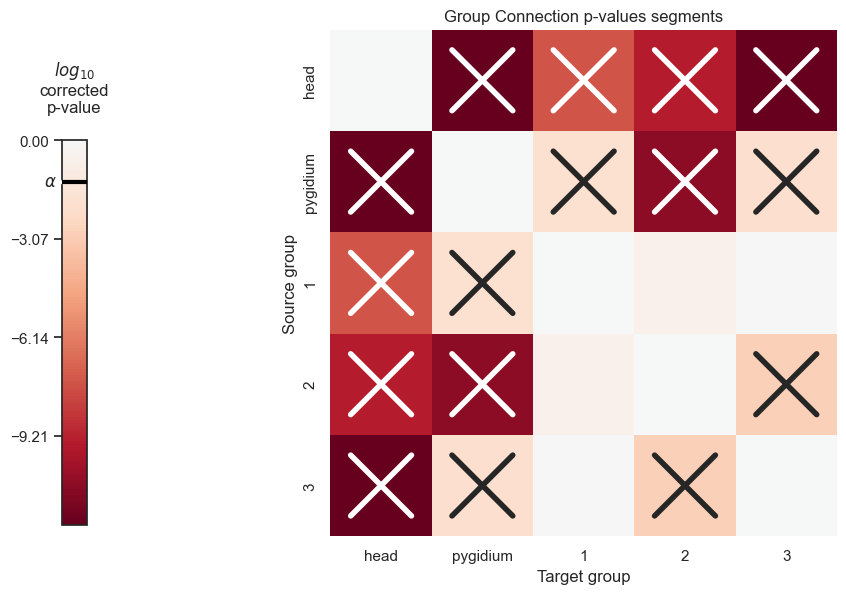
plot_pvals(df=pvals_df_bonferroni_corrected, names=segment_names, density_correct=False, bonferroni_correct=True, thres=thres)
plt.savefig(new_folder / "group_connection_heatmap_segments_bonferroni_corrected")
<matplotlib.collections.QuadMesh object at 0x1331c97f0>
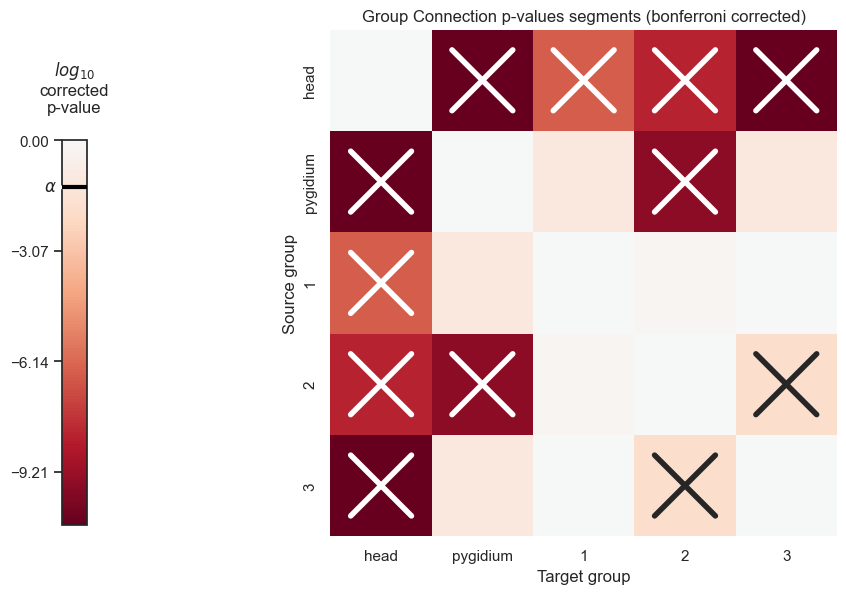
plot_pvals(df=pval_df_density_correct, names=segment_names, density_correct=True, thres=thres)
plt.savefig(new_folder / "group_connection_heatmap_segments_density_adjusted")
<matplotlib.collections.QuadMesh object at 0x133373df0>
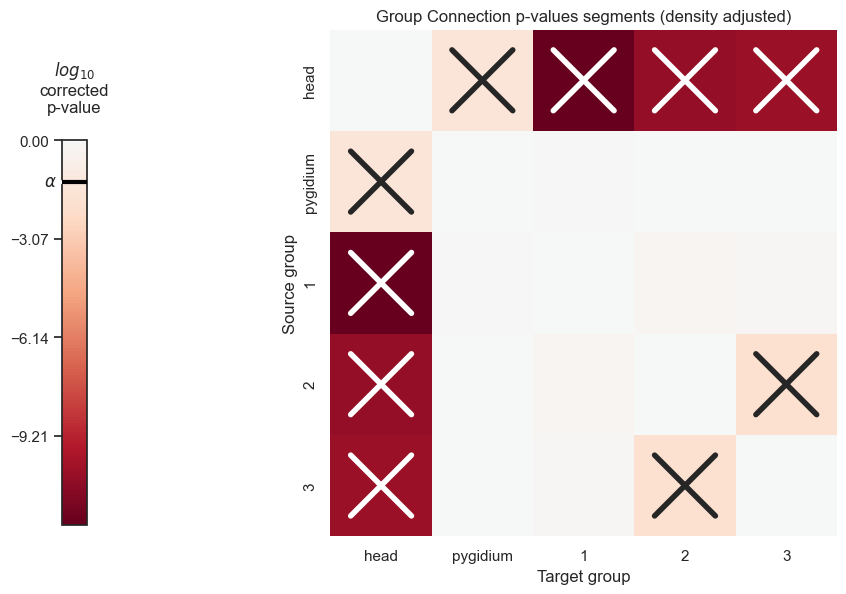
plot_pvals(df=pvals_df_density_corrected_bonferroni_corrected, names=segment_names, density_correct=True, bonferroni_correct=True, thres=thres)
plt.savefig(new_folder / "group_connection_heatmap_segments_density_adjusted_bonferroni_corrected")
<matplotlib.collections.QuadMesh object at 0x1357922b0>
